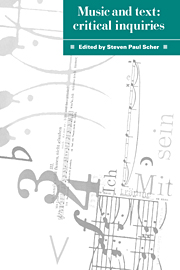Book contents
- Frontmatter
- Contents
- List of figures
- List of contributors
- Preface
- Acknowledgments
- Part I Institutional dimensions and the contexts of listening
- Part II Literary models for musical understanding: music, lyric, narrative, and metaphor
- Part III Representation, analysis, and semiotics
- 8 Music and representation: the instance of Haydn's Creation
- 9 Musical analysis as stage direction
- 10 Poet's love or composer's love?
- 11 The semiotic elements of a multiplanar discourse: John Harbison's setting of Michael Fried's “Depths”
- Part IV Gender and convention
- Index
11 - The semiotic elements of a multiplanar discourse: John Harbison's setting of Michael Fried's “Depths”
Published online by Cambridge University Press: 04 September 2009
- Frontmatter
- Contents
- List of figures
- List of contributors
- Preface
- Acknowledgments
- Part I Institutional dimensions and the contexts of listening
- Part II Literary models for musical understanding: music, lyric, narrative, and metaphor
- Part III Representation, analysis, and semiotics
- 8 Music and representation: the instance of Haydn's Creation
- 9 Musical analysis as stage direction
- 10 Poet's love or composer's love?
- 11 The semiotic elements of a multiplanar discourse: John Harbison's setting of Michael Fried's “Depths”
- Part IV Gender and convention
- Index
Summary
In one of the very few reviews ever published of John Harbison's song cycle The Flower-Fed Buffaloes, one critic observed that not only was Harbison's choice of poems too disparate for the work to be unified, the music was equally disconnected. The result was a farrago of ideas, a hodgepodge, a jumble that lacked any unifying elements, either musical or poetic. Indeed, the work initially appears to be quite chaotic. Harbison was commissioned by the New York State Bar Association to set to music a speech titled “The Spirit of Liberty” by Judge Learned Hand. Judge Hand was for many years the highly regarded and extremely popular Chief Judge of the New York Court of Appeals, and he wrote “The Spirit of Liberty” in 1944 to deliver in a ceremony granting citizenship to immigrants. However, rather than composing music to this particular text, Harbison created a parallel text from various poems which offered a broader range of themes about the American experience. These poems range from the rhythmic lines of Vachel Lindsay to the blank verse of Gary Snyder. Harbison's settings, too, explore a broad range of musical possibilities, from the use of a chorus accompanied by an unusual combination of instruments to a solo dramatic reading with percussion and piano. In the liner notes accompanying the recording of The Flower-Fed Buffaloes, Harbison explains that his “musical language draws on American vernacular throughout” and that his objective is to make audible the “rhythmic and harmonic connections below the verbal surface.”
- Type
- Chapter
- Information
- Music and TextCritical Inquiries, pp. 193 - 216Publisher: Cambridge University PressPrint publication year: 1992



